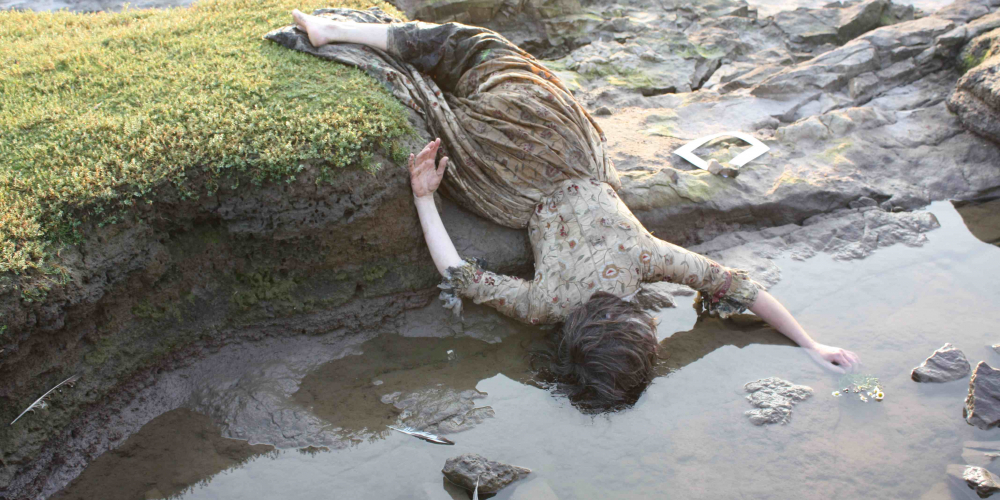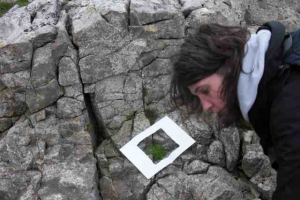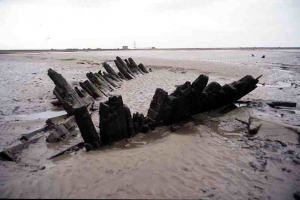Still Life

Still Life
Sept 2008 rev. 2009, Far Arnside, Morecambe Bay
Still Life was an intertidal performance specific to the sands of Morecambe Bay and the shoreline at Far Arnside, Lancashire, was also co-produced by Sap Dance and LAW Co, and was concerned with how we frame nature and what lies beyond the frame.
The performance took small groups of participants, who were led by a guide, from cliff-top to sandy-shore, over limestone rock and salt-marsh grass. Installations, made from objects discovered on site, provided trails for them to follow. These included fallen apples, pottery fragments, feathers, plastic bottles, flowers and blackberries. Along these trails, participants came across digital recordings, verbal descriptions, frames placed over natural and man-made objects, and photographs of objects no longer present (such as a dead gull and the sea at high tide). As they walked, a story unfolded concerning a woman from the past whom they witnessed out on the sands, and a weathered washed-up man from the present they beheld dancing on rocks.
I have never seen a piece of work in such a setting before and the performance heightened my immediate perception of it.
Nigel [Stewart] dancing on the rocks [...] opened up the focus and eye line of the audience to take in the enormity of the space [...] The environment as a whole felt very charged.
Louise Ann [Wilson's] hanting stillness was quite ominous and powerful. It was as if she was part of the surroundings, a presence that is always there and always watching – much like nature itself.
Audience Responses, Far Arnside, 2008.
Created and performed by: Louise Ann Wilson and Nigel Stewart (Sap Dance).
Guide: Derek Tarr.
Produced by: Louise Ann Wilson Co & Sap Dance.
The project arose from the AHRC-funded project Re-enchantment & Reclamation, Landscape and Environment Programme. It was funded by: Lancaster institute for the Contemporary Arts (LICA) & the Faculty of Arts and Social Science (FASS), Lancaster University.
Central to Still Life was the ways in which the spectators experience the three locations. That experience was built from creative tension between:
Composition. A number of different scientific and artistic techniques were used to guide and control spectators’ perceptions of the natural world as they are led on a specially-prepared journey through the location. They experienced:
-
a story concerning an C18 woman running out on the sands and a washed-up C21 man seen close and afar on the rocks and beach.
-
dances based on biomechanical studies and the movement notation of bird flight.
-
tape recordings concerning visual composition in landscape painting.
-
arrangements of artefacts of maritime history - pottery and glass.
-
installations and sculptures that frame found and gathered objects and are based on scientific methods of categorizing flora and fauna and re-presenting spatio-temporal patterns in nature.
In one way or another, these techniques and devices organize what’s at the location into a number of oppositions - between the human and other-than-human, indigenous and alien flora and fauna, symptoms and signs, planned and accidental acts. Through this binary logic each location is mapped, composed, understood, made “observable”.
Decomposition. Spectators also witnessed the outcome of the time spent in situ by the company prior to the performance. During this time the company experimented with ways in which all of its prepared material, the binary logic on which it is based, and the performers themselves are “decomposed” or “weathered” by the location’s physical conditions. In particular, they will see how this “weathering” is effected by gravity - through the pull of water, the withering of dead things, the effects of sun and water - and how this makes way for a new, if disorienting, perception of the otherness of place and, paradoxically, of the interdependence of place and person.
Central to Still Life was the ways in which the spectators experience the three locations. That experience was built from creative tension between:
Composition. A number of different scientific and artistic techniques were used to guide and control spectators’ perceptions of the natural world as they are led on a specially-prepared journey through the location. They experienced:
-
a story concerning an C18 woman running out on the sands and a washed-up C21 man seen close and afar on the rocks and beach.
-
dances based on biomechanical studies and the movement notation of bird flight.
-
tape recordings concerning visual composition in landscape painting.
-
arrangements of artefacts of maritime history - pottery and glass.
-
installations and sculptures that frame found and gathered objects and are based on scientific methods of categorizing flora and fauna and re-presenting spatio-temporal patterns in nature.
In one way or another, these techniques and devices organize what’s at the location into a number of oppositions - between the human and other-than-human, indigenous and alien flora and fauna, symptoms and signs, planned and accidental acts. Through this binary logic each location is mapped, composed, understood, made “observable”.
Decomposition. Spectators also witnessed the outcome of the time spent in situ by the company prior to the performance. During this time the company experimented with ways in which all of its prepared material, the binary logic on which it is based, and the performers themselves are “decomposed” or “weathered” by the location’s physical conditions. In particular, they will see how this “weathering” is effected by gravity - through the pull of water, the withering of dead things, the effects of sun and water - and how this makes way for a new, if disorienting, perception of the otherness of place and, paradoxically, of the interdependence of place and person.
Audience Responses
[...]. I loved how I was able to look far out to sea and then narrow my focus to the dancers, photographs or installations. The whole experience had a great sense of texture not possible in theatre. And I was gripped by the tension between the natural and the man-made.
[...]. Perhaps the most engaging impression for me was the sense of movement through space and thinking in very large compositional terms. [But] I cannot get the sound of Lou [Wilson’s] feet slap, slapping through the water’s edge, out of my mind.
Louise running in the water […] the sound, the movement, the dress, the human shape in the huge horizon and the Bay, and my recollections of the historical narratives of children dying in the sands, feeling that Louise represented their mother looking for them.
I loved the recordings. I really like that they were juxtaposed against our live experience. […] The recordings made me see the surroundings […] in a different way […]. They also spoke to me about how the manmade can never mimic the power of nature…..For the [recording] on bird flight a flock of oystercatchers rise from nowhere on the flats and circle twice over the finger of sky-coloured water - perfectly timed to the length of the spoken text!
I interpreted the empty photo frames as trying to frame nature and therefore de-naturalise the natural. Is this what the performance was doing by making us look at nature in a different way?....The placing/framing is clever and makes me see particular things among the infinite possible things and I'm drawn in. […]. The ‘framing’ of certain things led me to question whether/if some of those things framed were placed or found. It made me think about the way we take in and acknowledge our surroundings (or not).
I felt I had been given the time and focus to have a true experience of that location I found it affecting, and I thought the relation of figures to the Bay was very good sculpturally. It was very emotive and evocative - and unsentimental. The visual imagery made by the figures and movement, especially, did make me feel differently about that horizon.
The final tableau. Shocking, shocking. She is dead, her hair in the water, the […] wildflowers in her hand yet also in the water. Drowned? Almost certainly. Washed there and left there by the tide? Maybe.
How did it end? […] The guide leads me back to the real world. We say “wasn't it beautiful?” The beauty of the Bay and the sunset is so perfect. We alternate between awestruck wonder […] and delight.
Audience Responses
[...]. I loved how I was able to look far out to sea and then narrow my focus to the dancers, photographs or installations. The whole experience had a great sense of texture not possible in theatre. And I was gripped by the tension between the natural and the man-made.
[...]. Perhaps the most engaging impression for me was the sense of movement through space and thinking in very large compositional terms. [But] I cannot get the sound of Lou [Wilson’s] feet slap, slapping through the water’s edge, out of my mind.
Louise running in the water […] the sound, the movement, the dress, the human shape in the huge horizon and the Bay, and my recollections of the historical narratives of children dying in the sands, feeling that Louise represented their mother looking for them.
I loved the recordings. I really like that they were juxtaposed against our live experience. […] The recordings made me see the surroundings […] in a different way […]. They also spoke to me about how the manmade can never mimic the power of nature…..For the [recording] on bird flight a flock of oystercatchers rise from nowhere on the flats and circle twice over the finger of sky-coloured water - perfectly timed to the length of the spoken text!
I interpreted the empty photo frames as trying to frame nature and therefore de-naturalise the natural. Is this what the performance was doing by making us look at nature in a different way?....The placing/framing is clever and makes me see particular things among the infinite possible things and I'm drawn in. […]. The ‘framing’ of certain things led me to question whether/if some of those things framed were placed or found. It made me think about the way we take in and acknowledge our surroundings (or not).
I felt I had been given the time and focus to have a true experience of that location I found it affecting, and I thought the relation of figures to the Bay was very good sculpturally. It was very emotive and evocative - and unsentimental. The visual imagery made by the figures and movement, especially, did make me feel differently about that horizon.
The final tableau. Shocking, shocking. She is dead, her hair in the water, the […] wildflowers in her hand yet also in the water. Drowned? Almost certainly. Washed there and left there by the tide? Maybe.
How did it end? […] The guide leads me back to the real world. We say “wasn't it beautiful?” The beauty of the Bay and the sunset is so perfect. We alternate between awestruck wonder […] and delight.
Production Photographs by Nicola Tarr. Copyright LAW Co & Sap Dance


louise_ann_wilson_sbtd_catalogue_-_still_life_(2)_600_400_s_c1_c_c.jpg)
louise_ann_wilson_sbtd_catalogue_-_still_life_(3)_600_400_s_c1_c_c.jpg)
still_life_-_louise_ann_wilson_co__sap_dance_(25)_600_400_s_c1_c_c.jpg)

law_still_life_(4)_600_400_s_c1_c_c.jpg)
_600_400_s_c1_c_c.jpg)
law_still_life_(5)_600_400_s_c1_c_c.jpg)
law_still_life_(2)_600_400_s_c1_c_c.jpg)
still_life_-_louise_ann_wilson_co__sap_dance_(23)_300_200_s_c1_c_c.jpg)
still_life_-_louise_ann_wilson_co__sap_dance_(24)_300_200_s_c1_c_c.jpg)
still_life_-_louise_ann_wilson_co__sap_dance_(26)_300_200_s_c1_c_c.jpg)
still_life_-_louise_ann_wilson_co__sap_dance_(25)_300_200_s_c1_c_c.jpg)

still_life_-_louise_ann_wilson_co__sap_dance_(47)_600_400_s_c1_c_c.jpg)
_600_400_s_c1_c_c.JPG)

_300_200_s_c1_c_c.jpg)
_300_200_s_c1_c_c.jpg)


still_life_-_louise_ann_wilson_co__sap_dance_(20)_300_200_s_c1_c_c.jpg)
louise_ann_wilson_sbtd_catalogue_-_still_life_(2)_300_200_s_c1_c_c.jpg)
_300_200_s_c1_c_c.jpg)


_300_200_s_c1_c_c.jpg)
